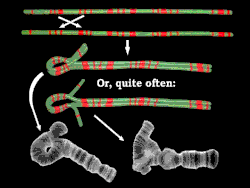Chromosome inversion

An inversion is a chromosome rearrangement out of mutation. In chromosome inversion, a segment of a chromosome is reversed end to end. An inversion is when the chromosome breaks at two points in a chromosome (or at the end) and does a 180 degree flip. The genes inside the inversion are in the reverse of the original order.
Consequences
What matters is whether the inversion interferes with crossing-over during meiosis. Meiosis is the type of cell division which produces sex cells (gametes).
Both chromosomes the same
If both chromosomes of a pair have the same inversion, and there is no extra or missing genes, then there is no problem with meiosis.
Inversion on one chromosome only
When the homologous chromosomes pair in prophase I of meiosis, the genes on the chromosomes pair up. The only way this can happen after an inversion is if the homologous pairs form a loop. If a cross-over occurs within this inversion loop, it can lead to loss or gain of DNA. For this reason, people with inversions in their germ cells often have lower fertility. This is because the gametes are damaged.
Families that are carriers of inversions may be offered genetic counselling and testing.[1]
Chromosome Inversion Media
A clay model showing why heterozygous inversion loops are visible in polytene chromosome preparations
Three chromosomal abnormalities with ISCN nomenclature, with increasing complexity: (A) A tumour karyotype in a male with loss of the Y chromosome, (B) Prader–Willi Syndrome i.e. deletion in the 15q11-q12 region and (C) an arbitrary karyotype that involves a variety of autosomal and allosomal abnormalities including inversions (abbreviated as inv).
References
- ↑ Gardner R.J.M. and Sutherland G.R. 2004. Chromosome abnormalities and genetic counseling. Oxford.


